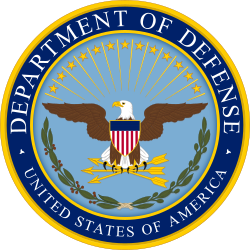
This is a partial list of agencies under the United States Department of Defense (DoD) which was formerly and briefly known as the National Military Establishment. Its main responsibilities are to control the United States Armed Forces. It is headed by the secretary of defense.
Contents
- Department of Defense agencies
- Field activities
- Other agencies
- Other DOD components
- Department of the Army
- Army Corps of Engineers: Divisions
- Army Corps of Engineers: Laboratories
- Army Commands (MACOMs)
- Department of the Navy
- Navy
- Marine Corps
- Department of the Air Force
- Air Force
- Space Force
- Unified Combatant Commands
- See also
- References
The department was established in 1947 and is divided into three major Departments—the Department of the Army, Navy and Air Force, as well as a number of other component organizations.


